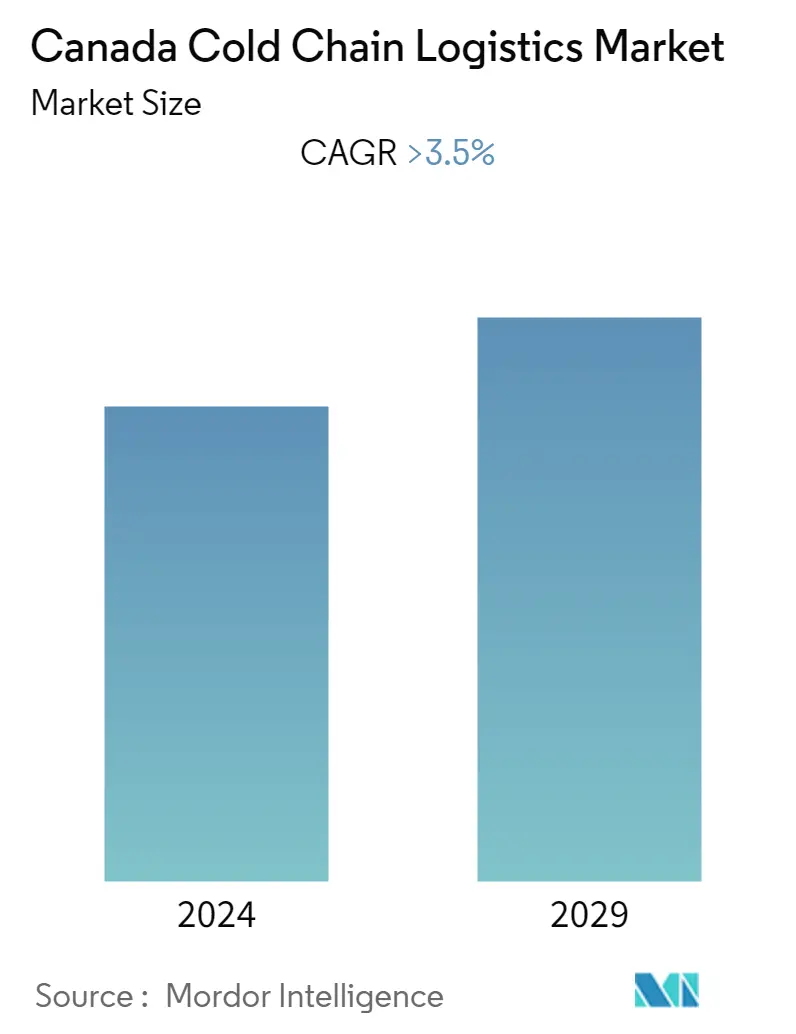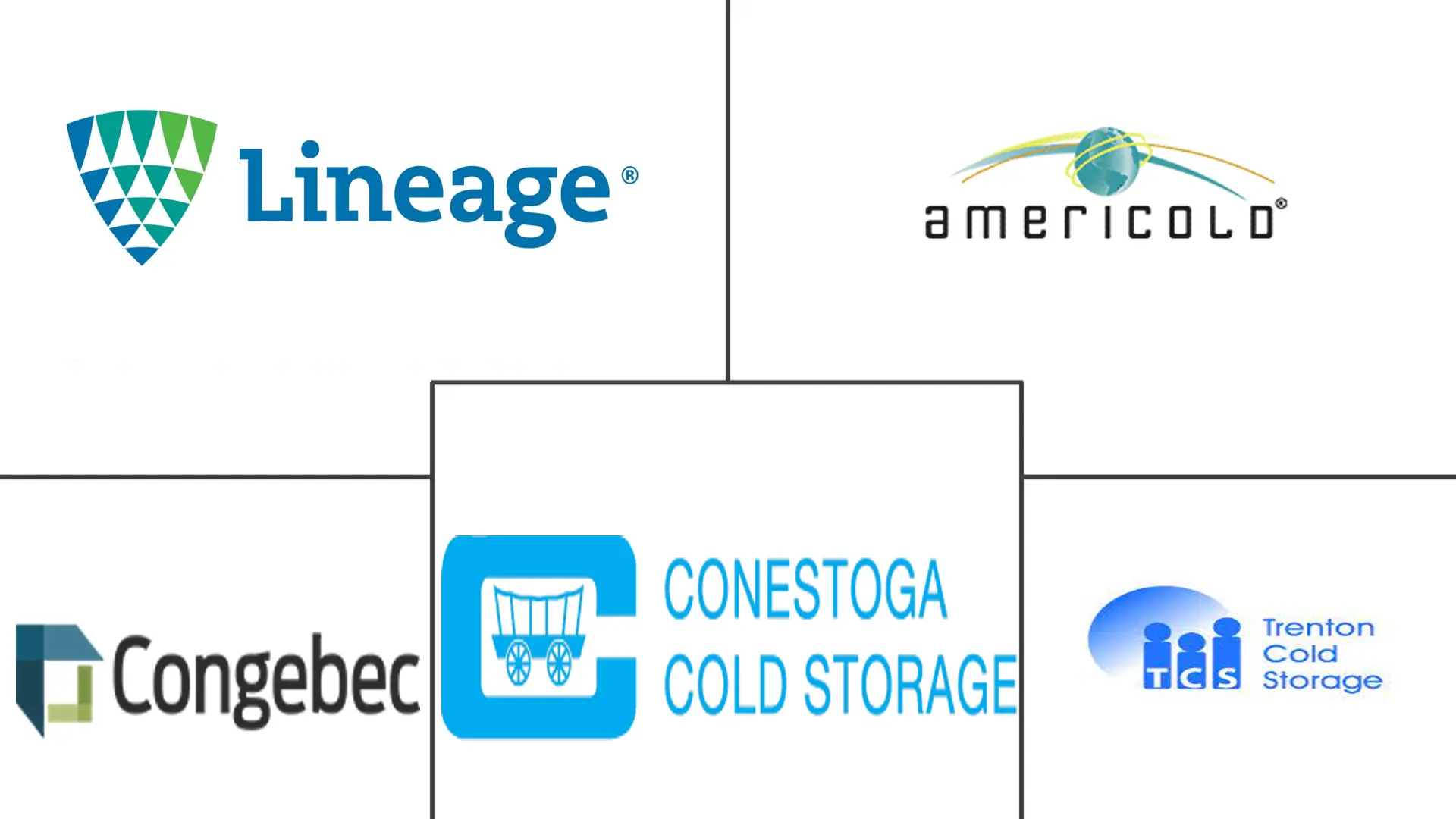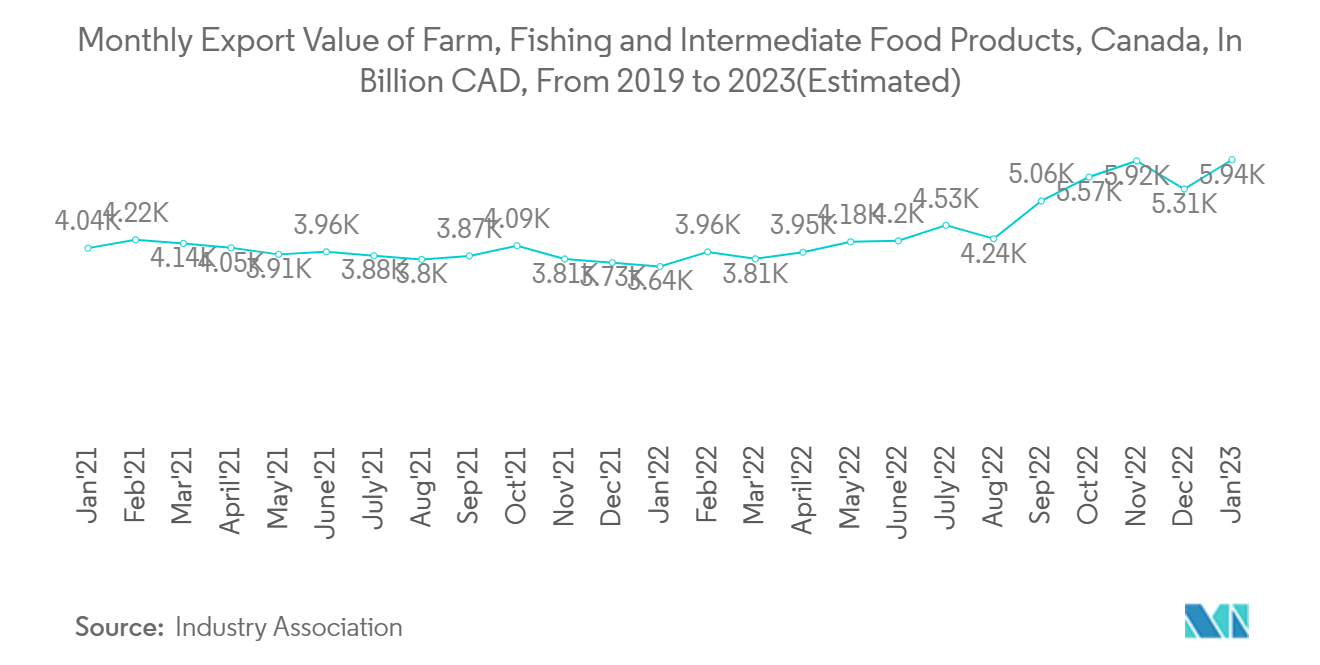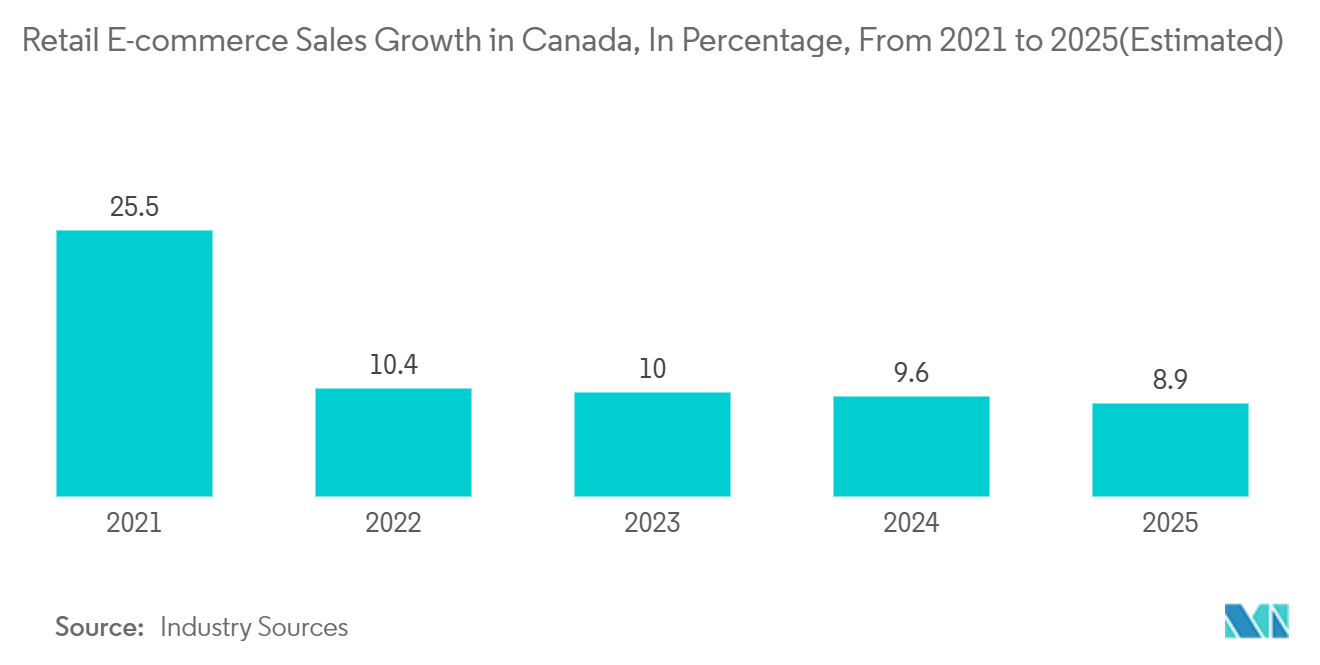Canada Cold Chain Logistics Market Size

| Study Period | 2024 - 2029 |
| Base Year For Estimation | 2023 |
| Forecast Data Period | 2024 - 2029 |
| CAGR | > 3.50 % |
| Market Concentration | High |
Major Players
*Disclaimer: Major Players sorted in no particular order |
Canada Cold Chain Logistics Market Analysis
The Canada Cold Chain Logistics market is valued at about USD 6.20 billion in the current year and is expected to grow at a CAGR of more than 3.5% during the forecast period.
- Crossborder supply chains are critical to the Canadian food sector, with significant volumes of food and agricultural products moving across the Canadian-U.S. border daily. The United States accounts for over 50% of the value of all Canadian agriculture and agrifood exports and around 60% of the value of Canadian food imports. The United States is a net importer of Canadian beef and cattle, Canada relies heavily on seasonal imports of fresh produce from the United States and Mexico. Cold chain logistics were important for a majority of the imports and exports as the products were perishable goods. The United States imports fresh produce worth over USD 22 billion yearly from over 125 different nations, while Mexico and Canada account for 77% and 11%, respectively, of the total fresh fruit and vegetable imports. It is critical to transport fresh produce effectively because their shelf lives are finite.
- The FSCC (food supply cold chain) is not dispersed fairly throughout the world. Ie. Canada has a strong FSCC that can maintain the proper temperature for all perishable food wherever it is needed. Despite this, it is known that the FSCC sometimes have interruptions or breaks. In Canada, 5% of avoidable food losses happen during distribution, 12% happen at the retail level, and 21% happen at the consumer level. It is thought that one of the main causes of these losses is inadequate temperature maintenance throughout the FSCC. The distance that food travels across Canada poses a significant problem for maintaining temperature. With a sizable population centred in urban regions dispersed across the nation and more communities dispersed throughout sizable rural and remote areas, Canada has a vast landmass. Road transportation is the main method used to deliver food to urban areas, whereas air transportation is used to transport food to remote places, particularly Northern villages.
- A significant global advantage for Canada lies in its numerous water ports. Ocean ports on the Pacific and Atlantic coasts open the Asian and European markets, respectively. In addition, the St. Lawrence Seaway provides expanded port service to several Canadian and U.S. locations in the Great Lakes. The Great Lakes offer outstanding intermodal logistics services to the central provinces of Canada and to the United States. Canada has distinct logistical capabilities that can be leveraged. For importing and exporting, Canada is a leader in port availability, infrastructure, and accessibility. Location, natural assets, and logistics support have created an environment to provide product distribution to global locations.
- Canada is a major exporter of fresh, chilled, and frozen meat, especially bovine products, and pork, as well as seafood products. Canada imports most of its fruits and vegetables because local production is relatively limited given the country's cold climate. The state (chilled or frozen) of imports and exports is specific to the food product. Most bovine products and salmon products that are imported and exported are fresh or chilled, while most pork imports, crab exports and lobster exports are frozen.
Canada Cold Chain Logistics Market Trends
Rise in Exports of Perishable Goods Driving the Demand for Cold Chain Logistics Services
Canada's exports of goods rose by 4.2% in January 2022 while imports rose by 3.1%. Canada's merchandise trade surplus with the rest of the world increased as a result, rising from a revised USD 1.2 billion in December 2022 to USD 1.9 billion in January 2023. In January 2022 total exports increased by 4.2% to USD 67.0 billion. All product categories saw growth in January 2022 with the exception of energy products. More than two-thirds of the rise in overall exports came from the increase in the farm, fisheries, intermediate food items, motor cars, and parts, as well as metal and non-metallic mineral products. Exports other than energy goods increased 6.1% to a record-high USD 51.6 billion. Real (or volume) terms exports as a whole increased by 5.3% in January 2022.
Exports of agriculture, fisheries, and intermediate food items grew 11.9% in January 2022 to reach USD 5.9 billion, a record level that was only marginally higher than that seen in November, after seeing their first decline in four months in December. The production of agriculture products revved up in the fall of 2022 and has been driving exports ever since, amid a harvest that significantly outperformed the previous one and robust worldwide demand. The rise in January 2023 was mostly attributable to exports of wheat, intermediate food items (canola oil), and other crop goods (soybeans).

Growth of E-commerce and Increasing Consumer Choices
Retail e-commerce sales have decreased as of July 2022 after experiencing a dramatic rise at the start of the pandemic, although they are still significantly higher than pre-pandemic levels. Retail e-commerce sales increased from 3.9% in 2019 to 6.2% in 2022 (July year to date) as a share of all retail sales. The percentages of retail e-commerce sales during the pandemic's peak in 2020 and 2021 were 6.6% and 6.9%, respectively. Retailers were hurt by a second wave of shop closures during the first half of 2021, which caused the share of retail e-commerce in total retail sales to a peak that year. In 2022, retail e-commerce sales continued to remain elevated in some subsectors, while in others, the resumption of in-store operations has led consumers and businesses to transition closer to pre-pandemic shopping preferences. Amazon dominates the entire e-commerce and shopping sector, with a robust presence in Canada's computers and electronics category. Its success is mainly due to its wide offerings, ranging from electronics to books, streaming, and television. That is, Amazon Canada attracts a diverse range of customers. Internet access provides an essential link to the rest of the world for residents in remote communities in Northern Canada, but delivering high-speed services remains costly and difficult. As of January 2022, 55 per cent of Canadians made online retail purchases with their mobile devices, and this trend is growing. Millennial consumers (ages 18-34) lead the movement, with 47% of these shoppers purchasing via digital devices at least once a week.
The Canadian E-commerce market is very similar to that of the United States, and it shares some of the same trends as retailers to the south. Hybrid purchases, "Click and Collect," and "omnichannel" consumers ordering products online and taking them home in a brick-and-mortar store seem to be two trends shaping the Canadian e-commerce market. The Canadian E-commerce market generally markets through social media because the return on investment by using social media is constantly improving, and retailers are increasingly spending marketing dollars on social media ads. In Canada, there are several methods for internet shopping to collect a payment, the most common of which are credit card-based - Interac Online, MasterPass, and PayPal -. Still, some vendors also offer the option of prepaid cards or prepaid vouchers. MasterCard is Canada's most popular credit card, accounting for a 53.6 % market share. In terms of consumer preferences, young Canadians are more willing to make mobile purchases and are more receptive to mobile advertisements. Another preference in Canada is for video advertising: according to Com Score, mobile commerce (m-commerce) is rising, owing to smartphones' and tablets' increasing mobile connectivity. Digital advertising has surpassed TV advertising revenues and is poised to become Canada's preferred advertising medium.

Canada Cold Chain Logistics Industry Overview
Canada's cold chain logistics market landscape is fragmented in nature with a mix of global and local players. Most of the imports and exports products need to be monitored in refrigerated transports. Due to technological development, companies are growing their market presence by developing new methods to manage cold chain logistics. Some of the strong players in the country are Americold Logistics, Congebec, Lineage Logistics Ltd and Conestoga amongst others. Canada is uniquely positioned to take advantage of emerging trade opportunities from developed economies and to serve as a gateway to North America. The cold chain logistics network in the country is well-developed, with a wide range of services, industries rely on transportation and logistics networks to deliver rapid, integrated, and secure solutions to leverage their global supply chains. The market started reviving from the pandemic by growing positively post-pandemic.
Canada Cold Chain Logistics Market Leaders
-
Americold Logistics
-
Lineage Logistics Ltd
-
Congebec Logistics, Inc.
-
Confederation Freezers
-
Conestoga Cold Storage
*Disclaimer: Major Players sorted in no particular order

Canada Cold Chain Logistics Market News
January 2023: Cargill announced it has completed the acquisition of Owensboro Grain Company, a fifth-generation family-owned soybean processing facility and refinery located in Owensboro, Ky. The addition of Owensboro Grain Company will enhance Cargill's efforts to increase capacity across its North American oilseeds network to support growing demand for oilseeds driven by food, feed and renewable fuel markets.
January 2022: CHS Inc. and Cargill, two of the nation's leading agribusinesses, announced the intent to expand the scope of their joint venture, TEMCO LLC, by adding the Cargill-owned export grain terminal in Houston, Texas. The addition of the Houston terminal will expand the joint venture's export capabilities, providing shipping access for grains, oilseeds and byproducts through the port of Houston.
September 2022: McCain Foods announces acquisition of Scelta Products, adding the Netherlands-based producer of frozen foods to its growing family of delicious, prepared vegetable appetizer product offerings. The deal closed on September 8, 2022 and represents a significant investment that will fuel McCain's growth and expansion in the frozen vegetable appetizer space.
Canada Cold Chain Logistics Market Report - Table of Contents
1. INTRODUCTION
1.1 Study Deliverables
1.2 Study Assumptions
1.3 Scope of the Study
2. RESEARCH METHODOLOGY
2.1 Analysis Methodology
2.2 Research Phases
3. EXECUTIVE SUMMARY
4. MARKET INSIGHTS
4.1 Current Market Scenario
4.2 Market Dynamics
4.2.1 Drivers
4.2.2 Restraints
4.2.3 Opportunities
4.3 Technological Trends and Automation
4.4 Government Regulations and Initiatives
4.5 Industry Value Chain/Supply Chain Analysis
4.6 Spotlight on Ambient/Temperature-controlled Storage
4.7 Industry Attractiveness - Porter's Five Forces Analysis
4.8 Impact of Emission Standards and Regulations on Cold Chain Industry
4.9 Impact of Covid-19 on the Market
5. MARKET SEGMENTATION
5.1 By Service
5.1.1 Storage
5.1.2 Transportation
5.1.3 Value-added Services (Blast Freezing, Labeling, Inventory Management, etc.)
5.2 By Temperature
5.2.1 Chilled
5.2.2 Frozen
5.2.3 Ambient
5.3 By End User
5.3.1 Horticulture (Fresh Fruits & Vegetables)
5.3.2 Dairy Products (Milk, Ice-cream, Butter, etc.)
5.3.3 Meats, Fish, Poultry
5.3.4 Processed Food Products
5.3.5 Pharma, Life Sciences, and Chemicals
5.3.6 Other End Users
6. COMPETITIVE LANDSCAPE
6.1 Market Concentration Overview
6.2 Company Profiles
6.2.1 Americold Logistics
6.2.2 Lineage Logistics Ltd
6.2.3 Congebec Logistics, Inc.
6.2.4 Conestoga Cold Storage
6.2.5 Confederation Freezers(Premium Brands Holdings Corporation)
6.2.6 Trenton Cold Storage, Inc.
6.2.7 Landtran Logistics Inc.
6.2.8 MTE Logistix
6.2.9 Groupe Robert
6.2.10 Yusen Logistics(Canada) Inc.*
- *List Not Exhaustive
7. MARKET OPPORTUNITIES AND FUTURE TRENDS
8. APPENDIX
8.1 Macroeconomic Indicators (GDP Distribution by Activity, Contribution of Transport and Storage Sector to economy)
8.2 Insights on Capital Flows (investments in Transport and Storage Sector)
8.3 E-commerce and Consumer Spending-related Statistics
8.4 External Trade Statistics - Export and Import
Canada Cold Chain Logistics Industry Segmentation
The technology and mechanism that allows for the secure delivery of temperature-sensitive goods and items along the supply chain are known as cold chain logistics. Any product that is perishable or is branded as such would almost certainly need cold chain management. Foods including meat and fish, produce, medical supplies, and pharmaceuticals could all fall under this category.
The Canadian Cold Chain Logistics Market is segmented by Service (Storage, Transportation, and Value-added Services), by Temperature Type (Chilled, Frozen, and Ambient), and by End User (Horticulture, Dairy Products, Meats, Fish, Poultry, Processed Food Products, Pharma, Life Sciences, and Chemicals, and Other Applications). A comprehensive background analysis of the Canadian Cold Chain Logistics Market covering the current market trends, restraints, technological updates, and detailed information on various segments and the competitive landscape of the industry. The report offers the market size and forecasts in values (USD billion) for all the above segments.
| By Service | |
| Storage | |
| Transportation | |
| Value-added Services (Blast Freezing, Labeling, Inventory Management, etc.) |
| By Temperature | |
| Chilled | |
| Frozen | |
| Ambient |
| By End User | |
| Horticulture (Fresh Fruits & Vegetables) | |
| Dairy Products (Milk, Ice-cream, Butter, etc.) | |
| Meats, Fish, Poultry | |
| Processed Food Products | |
| Pharma, Life Sciences, and Chemicals | |
| Other End Users |
Canada Cold Chain Logistics Market Research FAQs
What is the current Canada Cold Chain Logistics Market size?
The Canada Cold Chain Logistics Market is projected to register a CAGR of greater than 3.5% during the forecast period (2024-2029)
Who are the key players in Canada Cold Chain Logistics Market?
Americold Logistics, Lineage Logistics Ltd, Congebec Logistics, Inc., Confederation Freezers and Conestoga Cold Storage are the major companies operating in the Canada Cold Chain Logistics Market.
What years does this Canada Cold Chain Logistics Market cover?
The report covers the Canada Cold Chain Logistics Market historical market size for years: . The report also forecasts the Canada Cold Chain Logistics Market size for years: 2024, 2025, 2026, 2027, 2028 and 2029.
Canada Cold Chain Logistics Industry Report
Statistics for the 2024 Canada Cold Chain Logistics market share, size and revenue growth rate, created by Mordor Intelligence™ Industry Reports. Canada Cold Chain Logistics analysis includes a market forecast outlook to for 2024 to 2029 and historical overview. Get a sample of this industry analysis as a free report PDF download.



